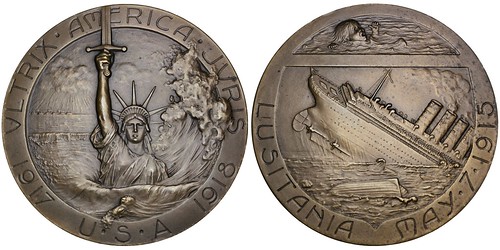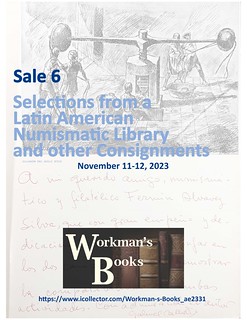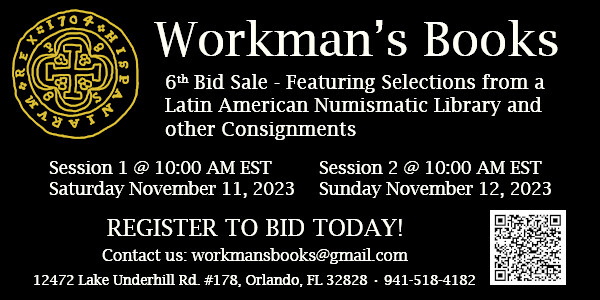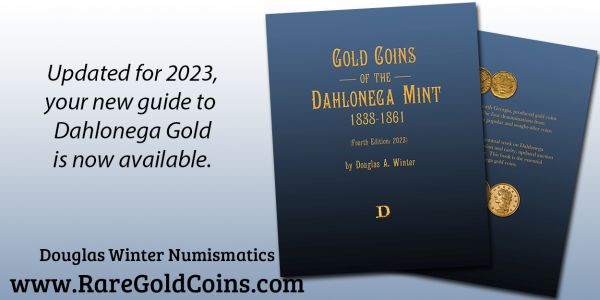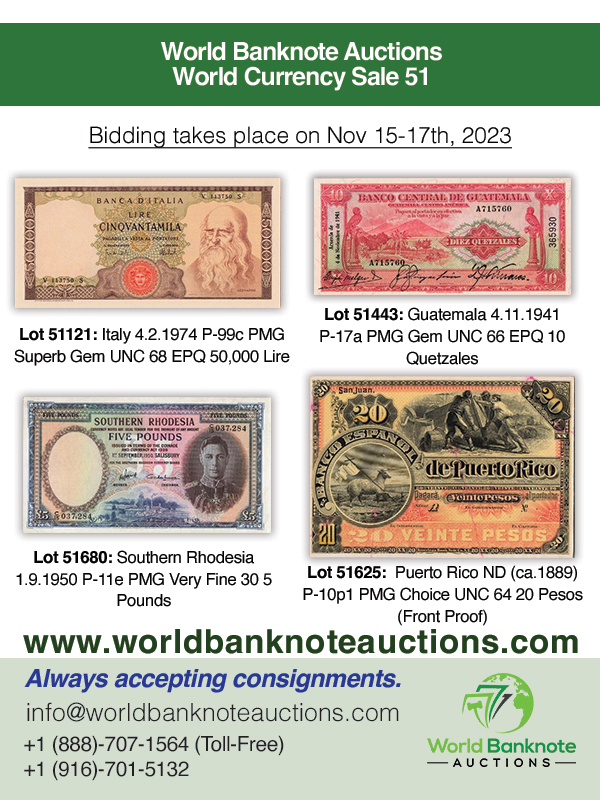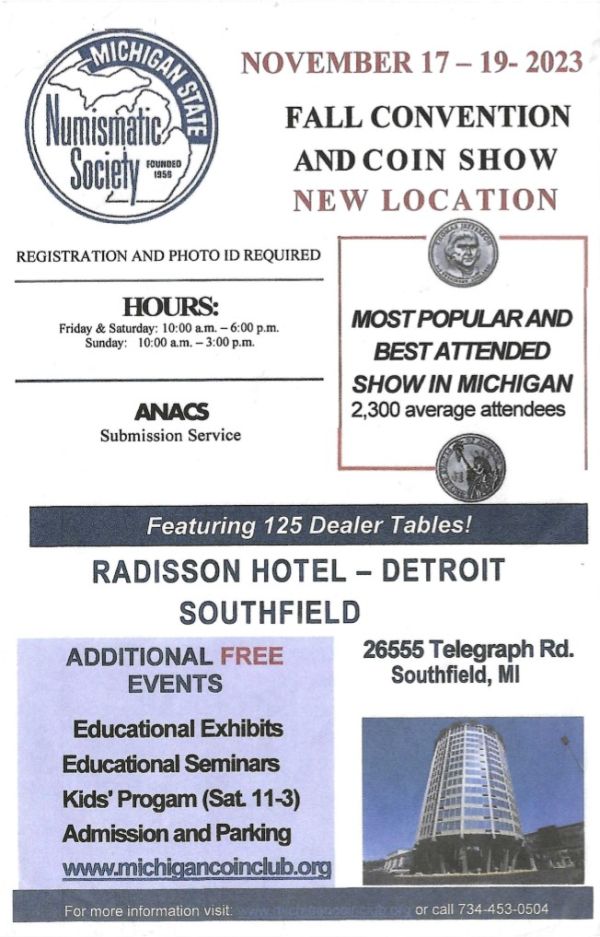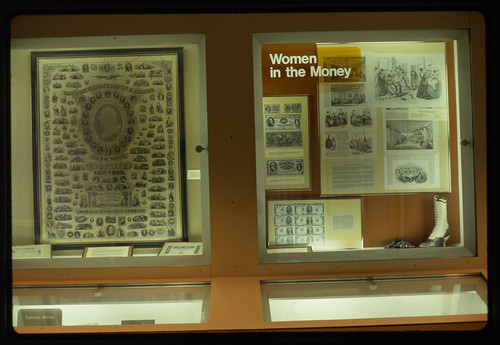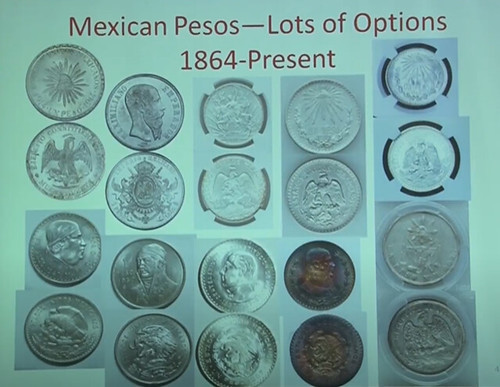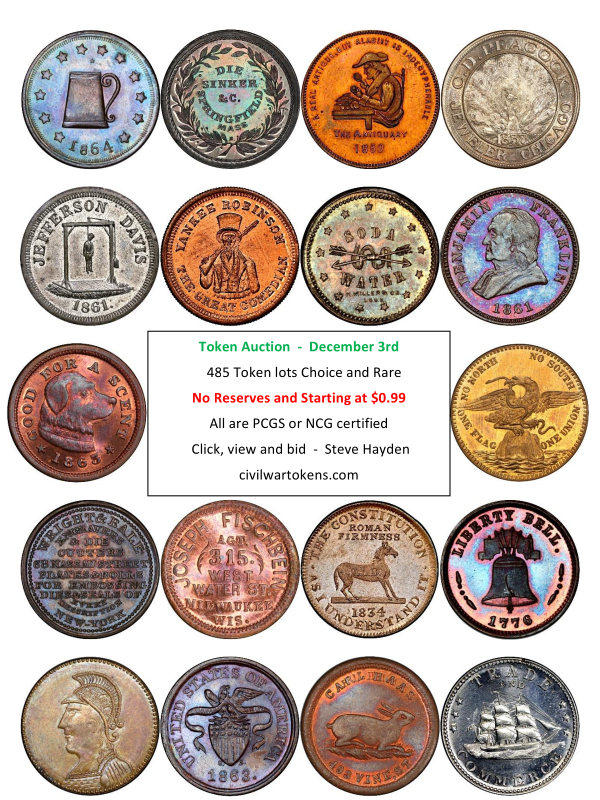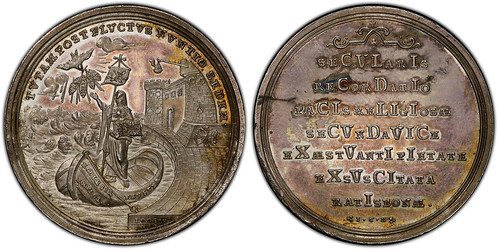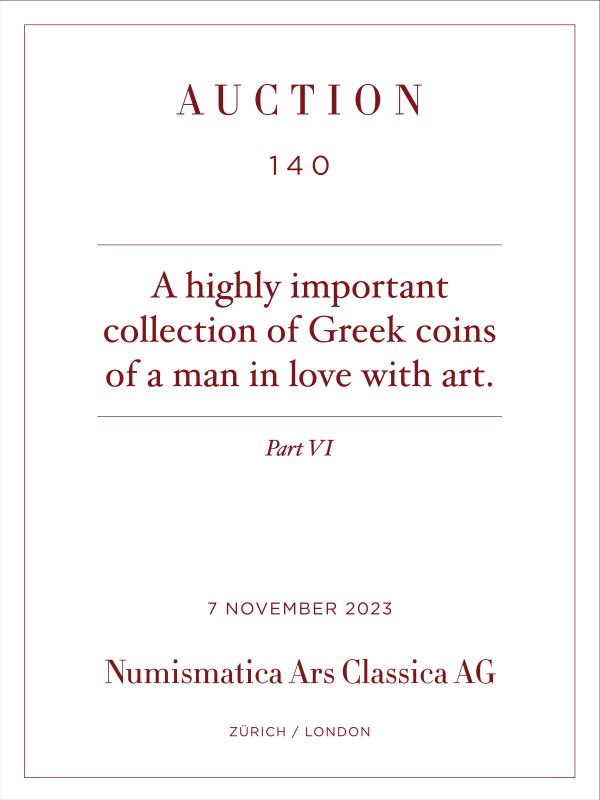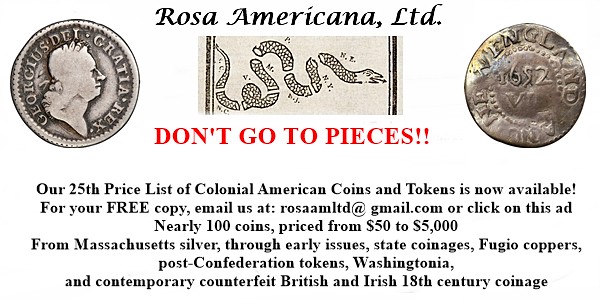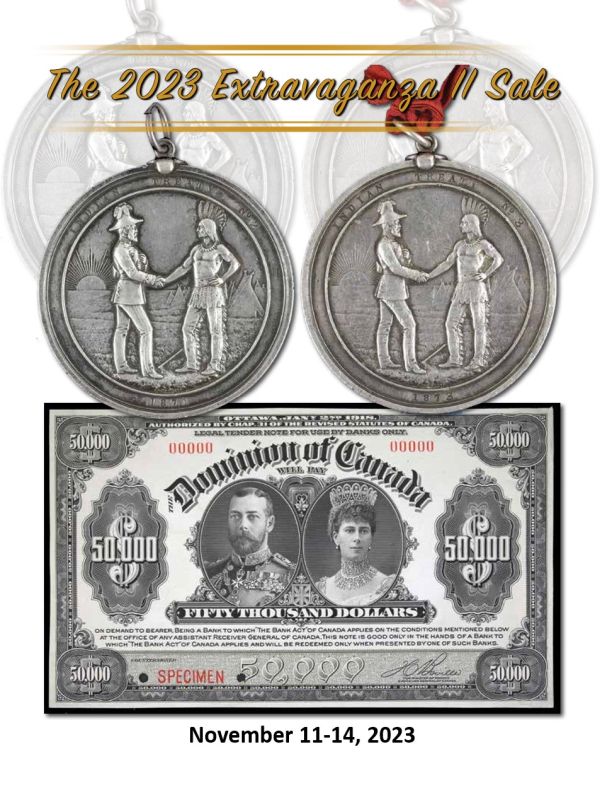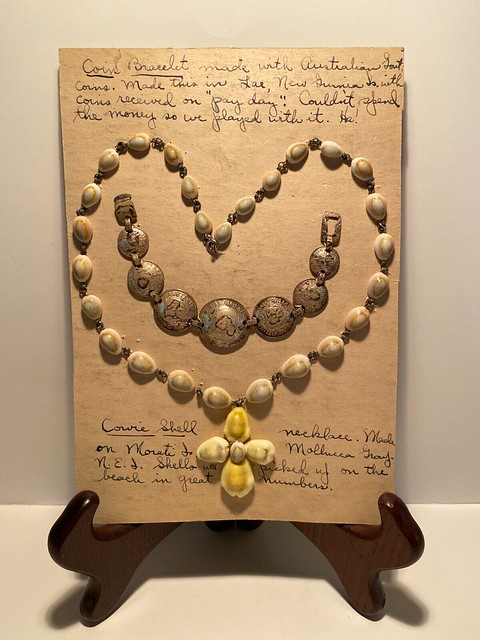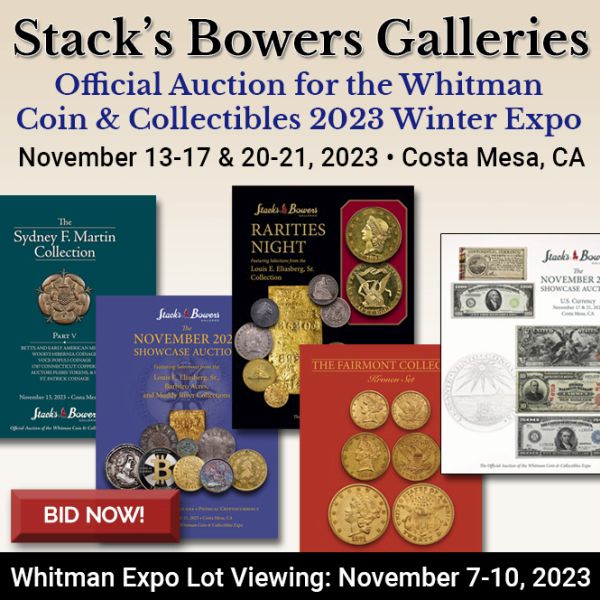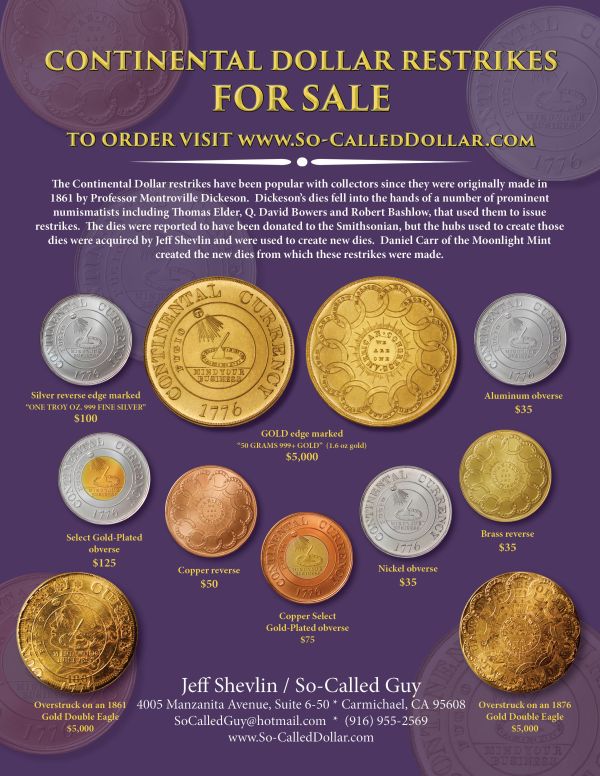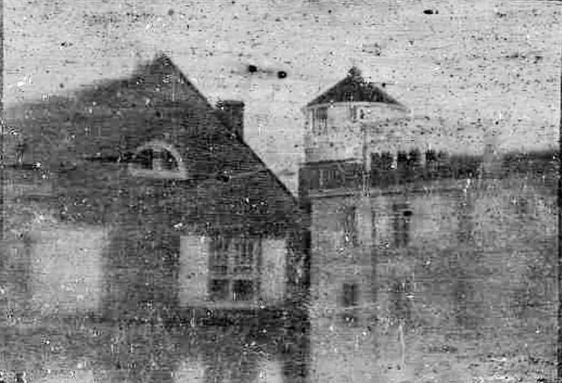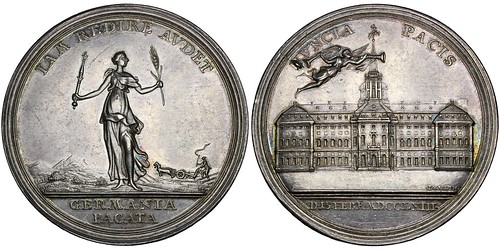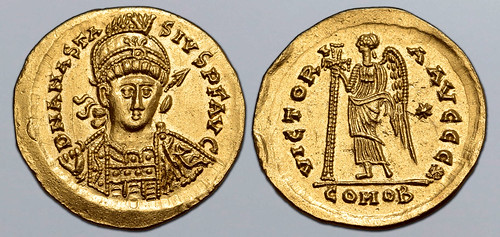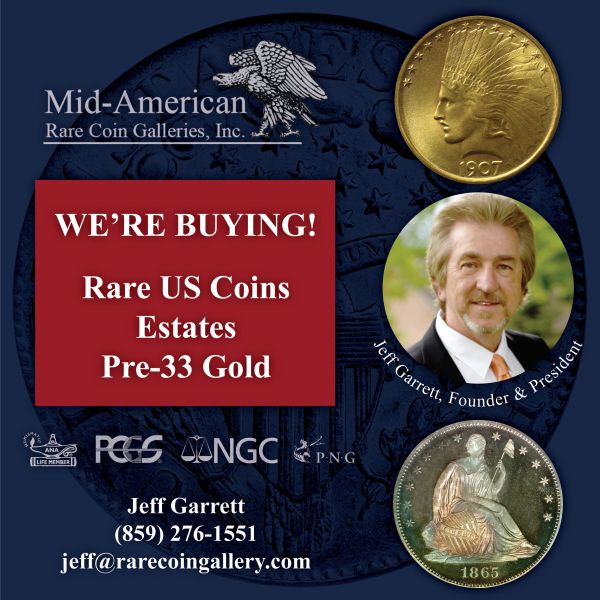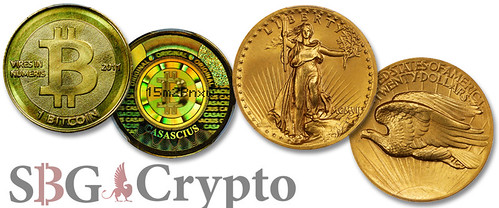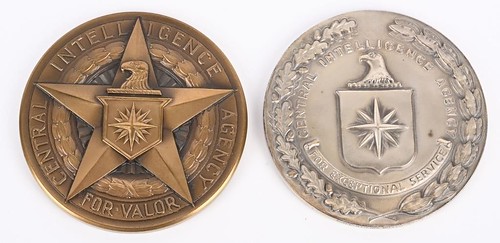
Visit our NBS Sponsors




About UsThe Numismatic Bibliomania Society is a non-profit association devoted to the study and enjoyment of numismatic literature. For more information please see our web site at coinbooks.org SubscriptionsThose wishing to become new E-Sylum subscribers (or wishing to Unsubscribe) can go to the following web page link MembershipThere is a membership application available on the web site Membership Application To join, print the application and return it with your check to the address printed on the application. Print/Digital membership is $40 to addresses in the U.S., and $60 elsewhere. A digital-only membership is available for $25. For those without web access, write to: Jeff Dickerson, Treasurer AsylumFor Asylum mailing address changes and other membership questions, contact Jeff at this email address: treasurer@coinbooks.org SubmissionsTo submit items for publication in The E-Sylum, write to the Editor at this address: whomren@gmail.com BUY THE BOOK BEFORE THE COINSale Calendar |
- WAYNE'S WORDS: THE E-SYLUM NOVEMBER 5, 2023
- MORE WORKMAN BOOKS SALE 6 SELECTIONS
- KüNKER SALE 399: ALOIS WENNINGER LIBRARY
- NEW BOOK: GUIDE BOOK OF LINCOLN CENTS, 4TH EDITION
- NEW BOOK: 2024 COINS OF CANADA 42ND EDITION
- NEW BOOK: NETHERLANDS TRADING SOCIETY
- NEW BOOK: ENGLISH PAPER MONEY 10TH EDITION
- NEW BOOK: VIRTUOUS BANKERS
- CDN PUBLISHING ACQUIRES WHITMAN
- MERCANTILE MONEY MUSEUM (1981-1996)
- VIDEO: MEXICAN SILVER PESO COINS
- DAVID SCHENKMAN INTERVIEW, PART ONE
- CHRONOGRAM QUIZ: 1755 AUGSBURG MEDAL
- WHAT WAS IN ASTOR'S POCKET?
- NOTES FROM E-SYLUM READERS: NOVEMBER 5, 2023
- MINIATURE NUMISMATIC LITERATURE
- WWII AUSTRALIAN COIN & COWRIE TRENCH ART
- VOCABULARY TERM: ORGANIC COATING
- DAVID LAWRENCE FEIGENBAUM (1941-2002)
- RON GILLIO INTERVIEW, PART FIVE
- SAINT-GAUDENS' GREAT PYRAMID PORTRAITS
- SAXTON'S 1839 PHOTO FROM THE U.S. MINT
- NUMISMAGRAM MEDAL SELECTIONS: NOVEMBER 5, 2023
- SOVEREIGN RARITIES AUCTION 11
- KUENKER AUCTIONS 398
- NUMISMATIC NUGGETS: NOVEMBER 5, 2023
- ANCIENT COINS FOUND OFF SARDINIA
- ANCIENT GREEK COINS RECOVERED IN ITALY
- THE PARADOX OF PHYSICAL CRYPTOCURRENCY
- PHYSICAL BITCOIN AS A NUMISMATIC COLLECTIBLE
- ENGRAVED CIA MEDALS OFFERED
- LOOSE CHANGE: NOVEMBER 5, 2023
Content presented in The E-Sylum is not necessarily researched or independently fact-checked, and views expressed do not necessarily represent those of the Numismatic Bibliomania Society.
WAYNE'S WORDS: THE E-SYLUM NOVEMBER 5, 2023
 New subscribers this week include:
Dean Birge and
Sophie B.
Welcome aboard!
New subscribers this week include:
Dean Birge and
Sophie B.
Welcome aboard!
Thank you for reading The E-Sylum. If you enjoy it, please send me the email addresses of friends you think may enjoy it as well and I'll send them a subscription. Contact me at whomren@gmail.com anytime regarding your subscription, or questions, comments or suggestions about our content.
Happy Guy Fawkes Day to our British friends. The short version of our email seems to reaching everyone now. My new problem is a broken shift key that has me typing like e. e. cummings.
This week we open with two numismatic literature sales, five new books, the acquisition of Whitman Publishing, updates from the Newman Numismatic Portal, notes from readers, and more, including the Mercantile Money Museum.
Other topics this week include David Schenkman, John Jacob Astor, David Lawrence Feigenbaum, Joseph Saxton, fixed price and auction listings, ancient coin finds, physical cryptocurrency, and CIA medals.
To learn more about Potosi cobs, Lincoln Cents, Canadian coins, the Netherlands Trading Society, the Bank of England, the Kill Huerta peso, chronograms, clearinghouses, miniature numismatic literature, trench art, California fractional gold, Augustus Saint-Gaudens and the Ames Monument, Treaty of Hubertusburg, the Oliver Cromwell crown, Numistamps and physical bitcoins and cryptocurrency, read on. Have a great week, everyone!
Wayne Homren
Editor, The E-Sylum
MORE WORKMAN BOOKS SALE 6 SELECTIONS
Alan Workman has a numismatic literature sale closing November 11-12, 2023. Here's some final selected lots. -Editor
Workman's Books is conducting its Sixth sale, "Sale 6 - Selections from A Latin American Numismatic Library and other Consignments.". Accompanying the Latin American Numismatic Library is a sizeable consignment of books, catalogs, magazines, journals, and dealer fixed price lists on numismatics, orders & decorations, militaria, shipwrecks, sunken treasure, lost treasure, treasure hunting, lost mines, and treasure in the American West.
- Books: 1 to 467
- Auction Catalogs & Dealer Fixed Pricelists: 468 to 734
SESSION 2:
- Auction Catalogs & Dealer Fixed Pricelists: 735 to 1267
- Journals & Magazines: 1268 to 1345
- Posters: 1346
- Newspapers: Lot 1347
- Photos: 1348 to 1349
- Postcards: 1350 to 1351
- VHS Tapes: 1352 to 1354
- DVDs: 1355
KüNKER SALE 399: ALOIS WENNINGER LIBRARY
The Künker eLive Premium Auction 399 is dedicated to the Alois Wenninger Library. Here is the press release followed by a number of selected lots. -Editor
Auction 399
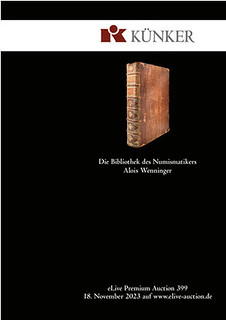 This is already the second time for a library of the outstanding coin dealer Alois Wenninger to be on sale. He sold his first library at the end of his career. It is hard to believe that he assembled this impressive specialist library, which will be on sale at Künker's eLive Premium Auction 399, in a single decade.
This is already the second time for a library of the outstanding coin dealer Alois Wenninger to be on sale. He sold his first library at the end of his career. It is hard to believe that he assembled this impressive specialist library, which will be on sale at Künker's eLive Premium Auction 399, in a single decade.
Alois Wenninger is an internationally renowned specialist for ancient coinage. As the long-term leader of the numismatic department of the Aufhäuser bank, he made a name for himself with his discoveries in research history. At the Aufhäuser bank, coins of Themistocles from cities ceded to him by the Persian ruler were first offered with accurate descriptions. Moreover, in the spring of 1991, Wenninger discovered a coin from the Roman Emperor Proculus, whose existence had been doubted previously, when offering a collection for sale. Today, the State Coin Collection in Munich is the proud owner of the piece.
NEW BOOK: GUIDE BOOK OF LINCOLN CENTS, 4TH EDITION
Whitman has released a new edition of the Dave Bowers book on Lincoln Cents. Here's the announcement. -Editor
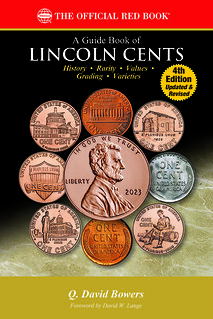 Whitman Publishing has released an expanded and revised fourth edition of its
best-selling Guide Book of Lincoln Cents. It continues in the popular tradition of the Guide Book of
Morgan Silver Dollars and other Bowers Series numismatic guides, which number more than two
dozen volumes. The 328-page full-color book is available online (including at Whitman.com) and
from booksellers nationwide.
Whitman Publishing has released an expanded and revised fourth edition of its
best-selling Guide Book of Lincoln Cents. It continues in the popular tradition of the Guide Book of
Morgan Silver Dollars and other Bowers Series numismatic guides, which number more than two
dozen volumes. The 328-page full-color book is available online (including at Whitman.com) and
from booksellers nationwide.
The new edition includes a thorough market analysis for each date and mintmark of Lincoln cent produced through 2023, with pricing in up to nine circulated and Mint State grades, plus Proofs. It features hundreds of photographs, and insight on U.S. Mint designers and sculptors, error coins, patterns, proposed Bicentennial designs, and more.
Appendices explore the Citizens Coinage Advisory Committee's review of the 2010 Union Shield reverse, a snapshot of the Lincoln cent market in 1946, and how to get a new die variety listed in collector publications such as the Red Book. An illustrated appendix on Abraham Lincoln tokens and medals, by the late Fred L. Reed, shows the president's broader influence on American numismatics.
NEW BOOK: 2024 COINS OF CANADA 42ND EDITION
The new edition of Coins of Canada is now available. -Editor
2024 Coins of Canada – 42nd Edition
by J.A. Haxby & R.C. Willey
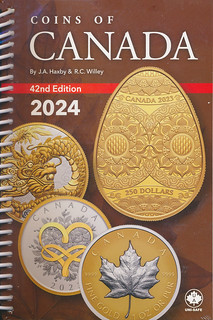 The 42ND edition of The Coins of Canada is a complete, one-volume library of Canadian coins, tokens and paper money, including major varieties.
The 42ND edition of The Coins of Canada is a complete, one-volume library of Canadian coins, tokens and paper money, including major varieties.
Features:
- Complete Canadian decimal coinage
- Pre-Confederation Provincial issues
- All Canadian Mint silver and gold collector's issues
- Canadian colonial tokens
- Dominion of Canada banknotes 1867-1935
- Bank of Canada paper money 1935 to date
- Latest retail market values by grade
- Detailed mintage figures and statistics
- Much historical background and pertinent information
- Condition Grading Guides for Canadian coins
- Includes a glossary of numismatic terms
NEW BOOK: NETHERLANDS TRADING SOCIETY
Ad Lansen and P. Plomp have published a new book on the monetary documents of the Netherlands Trading Society. -Editor
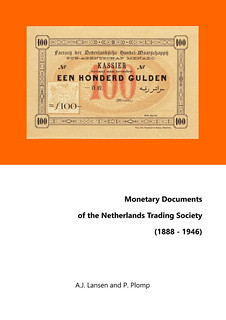 In this issue an overview of these cash orders and bank notes with extensive background information and provided with illustrations in color. A most complete, fascinating missing piece of monetary history of the Netherlands Trading Society.
In this issue an overview of these cash orders and bank notes with extensive background information and provided with illustrations in color. A most complete, fascinating missing piece of monetary history of the Netherlands Trading Society.
This book, annex catalog depicts the intriguing monetary history of the Netherlands Trading Society from 1888 to 1946. It is a unique publication that for the first time provides the most complete overview of the Dutch East Indies cash orders issued by them and the banknotes issued by the Shanghai agency.
NEW BOOK: ENGLISH PAPER MONEY 10TH EDITION
Pam West has published a new 10th edition of her book English Paper Money. -Editor
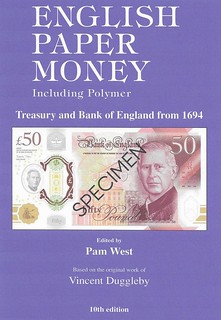 ENGLISH PAPER MONEY 10th Edition Including Polymer - Essential guide for every collector of Bank of England banknotes 1694 to date - Up to date information on all grades and values - Treasury notes from 1914 to 1928 - White £5 to £1000 - Branch rarity. The indispensable award winning Price Guide for English Paper Money.
ENGLISH PAPER MONEY 10th Edition Including Polymer - Essential guide for every collector of Bank of England banknotes 1694 to date - Up to date information on all grades and values - Treasury notes from 1914 to 1928 - White £5 to £1000 - Branch rarity. The indispensable award winning Price Guide for English Paper Money.
Within the book, Jennifer Adam, curator of the Bank of England Museum has written an article: The design and production of Bank of England notes, 1694 to 1928.
416 full colour pages with price guide and a new addition of research on all the white branch notes recorded in private hands.
EDITION: 10th
PRICE: £25.00 plus postage
NEW BOOK: VIRTUOUS BANKERS
Princeton University Press has published a book by Anne L. Murphy on the Bank of England in the 18th century. -Editor
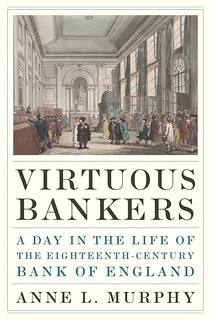 Virtuous Bankers: A Day in the Life of the Eighteenth-Century Bank of England
Virtuous Bankers: A Day in the Life of the Eighteenth-Century Bank of England
Anne L. Murphy
An intimate account of the eighteenth-century Bank of England that shows how a private institution became a great engine of state
The eighteenth-century Bank of England was an institution that operated for the benefit of its shareholders—and yet came to be considered, as Adam Smith described it, a great engine of state.
In Virtuous Bankers, Anne Murphy explores how this private organization became the guardian of the public credit upon which Britain's economic and geopolitical power was based. Drawing on the voluminous and detailed minute books of a Committee of Inspection that examined the Bank's workings in 1783–84, Murphy frames her account as a day in the life
of the Bank of England, looking at a day's worth of banking activities that ranged from the issuing of bank notes to the management of public funds.
CDN PUBLISHING ACQUIRES WHITMAN
CDN Publishing has acquired Whitman Publishing - here's the announcement. From left: John Feigenbaum, Charles Anderson, and Mary Burleson, with a presentation copy of the 1947 Guide Book of United States Coins—the original Red Book edition—by R.S. Yeoman. -Editor
Plans Digital Expansion and Other Innovations
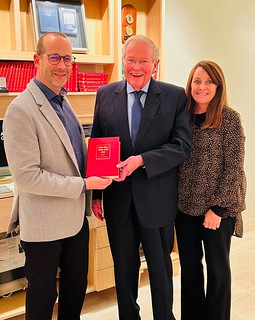 CDN Publishing, LLC, the prominent numismatic data company that
publishes the wholesale-pricing Greysheet and other resources, is pleased to announce it has
acquired Whitman Publishing, the leading firm in numismatic book-publishing. Included in the
acquisition are storied Whitman brands including H.E. Harris & Co. (stamps), Cowens
(supplies), and the Whitman Coin and Collectibles Expo. The deal was inked at Anderson Press
headquarters in Florence, Alabama, on October 31, 2023. Management and staffing of both
companies will remain in place, with main offices in Alabama and Virginia.
CDN Publishing, LLC, the prominent numismatic data company that
publishes the wholesale-pricing Greysheet and other resources, is pleased to announce it has
acquired Whitman Publishing, the leading firm in numismatic book-publishing. Included in the
acquisition are storied Whitman brands including H.E. Harris & Co. (stamps), Cowens
(supplies), and the Whitman Coin and Collectibles Expo. The deal was inked at Anderson Press
headquarters in Florence, Alabama, on October 31, 2023. Management and staffing of both
companies will remain in place, with main offices in Alabama and Virginia.
The acquisition is expected to bring fast growth to Whitman's expansion in the digital arena. The combined companies will deliver even more data-driven resources to coin and paper-money collectors, dealers, and researchers.
CDN has established the Monthly Greysheet and CDN Exchange as the industry standards in
wholesale pricing and dealer-to-dealer buying, bidding, and selling rare coins and currency,
said
president and CEO John Feigenbaum. Since 2015 we've expanded our business in monthly and
quarterly publications and other print and online resources. As we continue to grow, it makes
perfect sense to move into the world of numismatic book-publishing and there's no company in
that field that compares to Whitman.
MERCANTILE MONEY MUSEUM (1981-1996)
The latest addition to the Newman Numismatic Portal is a set of images of founder Eric Newman's Mercantile Money Museum in St. Louis. Project Coordinator Len Augsburger provided the following report. -Editor
Mercantile Money Museum (1981-1996)
Recently digitized by Newman Portal are a set of color transparencies from the Mercantile Money Museum, which operated in downtown St. Louis at the Mercantile Bank from 1981 to 1996 under the direction of Eric P. Newman. The Mercantile Money Museum was closed in 1996 and revived in 2006 as the Newman Money Museum, which then operated in the Kemper Art building at Washington University from 2006-2018. Prior to closure of the Newman Money Museum, an extensive series of videos documented the Money Museum and individual cases for posterity.
VIDEO: MEXICAN SILVER PESO COINS
The David Lisot Video Library on the Newman Numismatic Portal can be found at:
https://nnp.wustl.edu/library/multimediadetail/522852
We highlight one of his videos each week in The E-Sylum. Here's one from 2017 with Jay Chamberlain speaking about Mexican silver pesos on behalf of Dr. Bart Bartanowicz. -Editor
DAVID SCHENKMAN INTERVIEW, PART ONE
Greg Bennick's latest interview for the Newman Numismatic Portal is with token expert David Schenkman. Here's the first of six parts, where Dave discusses getting started as a collector and dealer. -Editor
Greg Bennick: Hi everybody, this is Greg Bennick with the Newman Numismatic Portal. I've been doing a series of interviews with numismatists, collectors and dealers from around the world, and this is yet another installment in that series. And I'm really excited today because today with me, I have David Schenkman. We're going to be talking about tokens and medals, we're going to be talking about his extensive numismatic history, and I'm really excited for this interview. So David, thank you so much for being here today.
David Schenkman: It's my pleasure.
Greg Bennick: Well, I wanted to dive right in just with some origins. And I think that my intention with interviewing you is going to take a couple of different paths. One is the basic path, meaning for folks who maybe haven't encountered tokens and medals and other things you've specialized in. And then the other path will be for more of the specialists, like we'll talk about some specific pieces and some more details about those avenues that you've explored, but let's start with your origins. What was your origin story in terms of coins and tokens and collecting? How did that all come about?
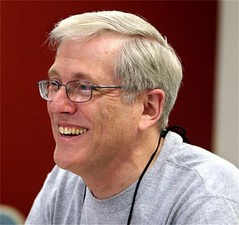 David Schenkman: I started collecting stamps at a very early age. When I was nine years old,
my mother gave me a box of Indian head pennies that she'd had since she was a girl, and
immediately I liked them better than I did stamps. They were tangible items that could actually
be spent. I never did. So I became interested in those, and then shortly after that, one of my
aunts who lived in Colorado sent me a silver dollar, a Morgan dollar. That was really
meaningful to me, so that was my introduction. And it wasn't long before I got one of the blue
books and then a Red Book. I think my first Red Book was not until about 1955, but I started
looking at them and started collecting.
David Schenkman: I started collecting stamps at a very early age. When I was nine years old,
my mother gave me a box of Indian head pennies that she'd had since she was a girl, and
immediately I liked them better than I did stamps. They were tangible items that could actually
be spent. I never did. So I became interested in those, and then shortly after that, one of my
aunts who lived in Colorado sent me a silver dollar, a Morgan dollar. That was really
meaningful to me, so that was my introduction. And it wasn't long before I got one of the blue
books and then a Red Book. I think my first Red Book was not until about 1955, but I started
looking at them and started collecting.
CHRONOGRAM QUIZ: 1755 AUGSBURG MEDAL
Last week I asked, "Oh, and who can spot the chronogram in this issue?" Dave Schenkman was the first to respond, correctly identifying the 1755 Augsburg medal in the Atlas Numismatics article. Bingo! -Editor
1076053 | GERMAN STATES. Augsburg. 1755 AR Medal. PCGS SP63. By G. F. Loos. 14.69mm. 37.7gm. Allegorical figure of Religion steering a boat and holding open a book and flag with ChiRho; a dove of peace to left and city fortifications to right / Legend on seven-lines; date below. Whiting 506; Erlanger 2215; Plato 180.
THE BOOK BAZARRE
Bowers Series.It's a history-packed reference for both investors and collectors of the popular bullion series. Foreword by Q. David Bowers. 384 pages. Order your copy online at Whitman.com , or call 1-800-546-2995.
WHAT WAS IN ASTOR'S POCKET?
Last week Barry Tatum asked if anything was known about the denominations of the money found in the pockets of John Jacob Astor, who died on the Titanic. Pete Smith submitted this great response. Thank you! The image is from an earlier article about other cash recovered from the shipwreck. -Editor
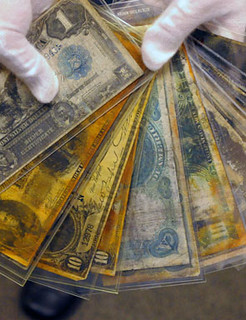 There are a couple of references that list the personal effects found with the body of John Jacob Astor including Encyclopedia Titanica. As each of the recovered bodies was examined, there was an inventory made of the personal effects. Astor was number 124 out of 330 bodies listed.
There are a couple of references that list the personal effects found with the body of John Jacob Astor including Encyclopedia Titanica. As each of the recovered bodies was examined, there was an inventory made of the personal effects. Astor was number 124 out of 330 bodies listed.
Gold watch, cuff links gold and diamond, diamond ring with three stones, £225 in English
notes, $2440 in notes, £5 in gold, 7s. in silver; 5 ten franc pieces, and gold pencil; and pocket book.
NOTES FROM E-SYLUM READERS: NOVEMBER 5, 2023
On Missing Birth Certificates
Harry Salyards writes:
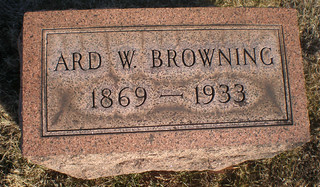 "Just a cautionary note, with regard to no birth certificate having been found for Ard Browning (neé Bolenbaugh)--The legal requirement for birth (and death) certificates was imposed state by state, over a period of many decades. I don't know what the situation was in Illinois, but I do know that my late mother-in-law, who was born in Kentucky in 1905, had no birth certificate--a fact which caused her considerable grief when she first applied for a passport. I also know that death certificates were not yet required in Nebraska when my great grandmother died in 1901, because I have looked in vain for such a record."
"Just a cautionary note, with regard to no birth certificate having been found for Ard Browning (neé Bolenbaugh)--The legal requirement for birth (and death) certificates was imposed state by state, over a period of many decades. I don't know what the situation was in Illinois, but I do know that my late mother-in-law, who was born in Kentucky in 1905, had no birth certificate--a fact which caused her considerable grief when she first applied for a passport. I also know that death certificates were not yet required in Nebraska when my great grandmother died in 1901, because I have looked in vain for such a record."
Good point. Unfortunate, but true. -Editor
To read the earlier E-Sylum article, see:
ARD BROWNING DISCOVERY
(https://www.coinbooks.org/v26/esylum_v26n44a13.html)
Other topics this week include the Value of Union and Confederate Currency and bank clearinghouses. -Editor
MINIATURE NUMISMATIC LITERATURE
Adrián González-Salinas writes:
"Last 12 September 2023 I gave a lecture on Miniature Numismatic Literature at the monthly meeting of the Numismatic Society of Monterrey (Mexico). My starting point was the ANS article "Small Wonders: Miniature and Pocket-Sized Numismatic Literature".
"In Mexico, the smallest numismatic book I have been able to locate is Neil S. Utberg's "The Coins of Estados Unidos Mexicanos 1905-1965" from 1965 [24 pages, 7.6 x 10.9 cms (82.84 square cms)]."
WWII AUSTRALIAN COIN & COWRIE TRENCH ART
Carol Bastable submitted these notes on an interesting recent purchase. Thanks! -Editor
I found this on eBay complete with written text and I thought that bibliophiles might be the right group to share it with. It is a fairly ordinary WWII coin bracelet along with a cowrie shell necklace, but what is interesting is the backer board that these items are stitched onto.
The coin bracelet was made in Lae New Guinea by a soldier. The soldier explains that he got the coins for payday but could not spend them, so he played with them to create the bracelet. I am not certain if his not being able to spend the coins was because he could not spend Australian coins in New Guinea and he would have to wait until a leave to Australia or if there was nowhere to shop nearby. Also of note, is that the bracelet's catch and the links between the coins were probably made from coins. I just purchased this and will have to wait until it arrives to fully inspect it. However, jeweler supplies were not a thing that one would find on the front, so soldiers were inventive.
VOCABULARY TERM: ORGANIC COATING
Here's another entry from Dick Johnson's Encyclopedia of Coin and Medal Terminology. -Editor
Organic Coating. A painted surface. Medallic items can be painted to give color to their surface, but this is a less satisfactory finish than other types of patina finishes, as say, a chemical patina. A painted medallic surface has a tendency to wear through, or chip, or break away, particularly on the high points of a medallic item. A 20th century example is the Fairmont Park Art Association Medal of Honor, 1937, which has a black paint finish. The Iron Cross decoration of Germany in lower grades is painted black. The Theodore Roosevelt Plaque (illustrating the entry quotation) has a brown organic coating. Anyone who has played with toy soldiers quickly learns the effect of paint on metal; the coated paint easily chips off exposing the bare metal underneath. All such organic coatings applied to metal are thus susceptible to chipping away their color coatings. See also colorize.
DAVID LAWRENCE FEIGENBAUM (1941-2002)
E-Sylum Feature Writer and American Numismatic Biographies author Pete Smith submitted this article on David Lawrence Feigenbaum and his numismatic publishing and business legacy. Thanks! -Editor
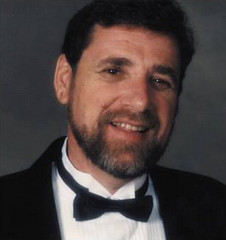 David was born in New York City on August 4, 1941, the son of Philip Feigenbaum and
Madeline Goodfriend. He graduated from Cornell University with a degree in mechanical
engineering. He received an M.S. and Ph.D. in oceanography from the University of Miami. In
1963, he was married to Lynn Friedhoff. They had a son, John, and a daughter.
David was born in New York City on August 4, 1941, the son of Philip Feigenbaum and
Madeline Goodfriend. He graduated from Cornell University with a degree in mechanical
engineering. He received an M.S. and Ph.D. in oceanography from the University of Miami. In
1963, he was married to Lynn Friedhoff. They had a son, John, and a daughter.
He was a high school teacher prior to 1980. Then he was on the faculty at Old Dominion University in Norfolk, Virginia, after 1980.
RON GILLIO INTERVIEW, PART FIVE
Greg Bennick's latest interview for the Newman Numismatic Portal is with longtime dealer Ron Gillio. Here's the fifth and final part, where Ron discusses working for Stack's Bowers and his favorite coin, the 1894 S-Dime. -Editor
Greg Bennick: Pretty interesting. I like that. Now, tell me, you mentioned earlier working for a couple of times, working for Stacks Bowers. Can you tell me how you got connected to Stacks Bowers and what that experience has been like?
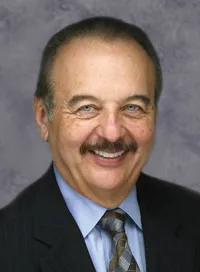 RON GILLIO: Well, Stacks Bowers, I mean, what happened was, as I mentioned
earlier also, I sold the Long Beach Coin Show to David Hall in 2005. At the same
period of time, I was doing a lot of business with Greg Roberts, who's the CEO of
Stacks Bowers and who started The Spectrum Group, which is still part of Stacks
Bowers. And I've been friends with him for 35 years, and we were doing a lot of
business. And he just said to me, so you sold the Long Beach Coin Show, you got
time on your hands, why don't you become a consultant for us? And you can do what
you do, go to Europe, buy, and sell coins, and you'll just be doing it for Stacks
Bowers, so on and so forth. So that was 16 years ago now.
It all started by he wanted to maybe get something started in the Orient. So, we
planned a trip. He hired me, I think in March, there was the Tokyo International Coin
Show every May time period. So that was my first venture out. We got a table at the
Tokyo show and he went there with a couple of other employees and myself from
Stacks Bowers and got things rolling.
RON GILLIO: Well, Stacks Bowers, I mean, what happened was, as I mentioned
earlier also, I sold the Long Beach Coin Show to David Hall in 2005. At the same
period of time, I was doing a lot of business with Greg Roberts, who's the CEO of
Stacks Bowers and who started The Spectrum Group, which is still part of Stacks
Bowers. And I've been friends with him for 35 years, and we were doing a lot of
business. And he just said to me, so you sold the Long Beach Coin Show, you got
time on your hands, why don't you become a consultant for us? And you can do what
you do, go to Europe, buy, and sell coins, and you'll just be doing it for Stacks
Bowers, so on and so forth. So that was 16 years ago now.
It all started by he wanted to maybe get something started in the Orient. So, we
planned a trip. He hired me, I think in March, there was the Tokyo International Coin
Show every May time period. So that was my first venture out. We got a table at the
Tokyo show and he went there with a couple of other employees and myself from
Stacks Bowers and got things rolling.
Greg Bennick: Fantastic. And I'm assuming you worked and were connected to Dave Bowers as well. I was just curious what it was like to work with Dave. I've had very, very little interaction with him over the years, so I'm just always curious to ask.
SAINT-GAUDENS' GREAT PYRAMID PORTRAITS
Sculptor Augustus Saint-Gaudens, whom numismatists know as the designer of iconic U.S. coins and medals, was primarily known for statues and sculptural work found all over major cities. But did you know about his two nine-foot tall portraits near a ghost town in rural Wyoming? On the side of a freakin' pyramid? Me neither. Wikipedia tells the tale... -Editor
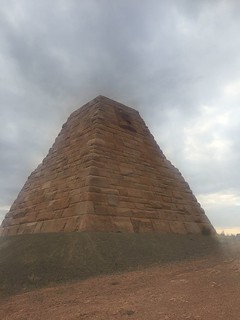 The Ames Monument is a large pyramid in Albany County, Wyoming, designed by Henry Hobson Richardson and dedicated to brothers Oakes Ames and Oliver Ames Jr., Union Pacific Railroad financiers. It marked the highest point on the first transcontinental railroad, at 8,247 feet (2,514 m).
The Ames Monument is a large pyramid in Albany County, Wyoming, designed by Henry Hobson Richardson and dedicated to brothers Oakes Ames and Oliver Ames Jr., Union Pacific Railroad financiers. It marked the highest point on the first transcontinental railroad, at 8,247 feet (2,514 m).
The town of Sherman rose up around it, but then Union Pacific moved its tracks to the south, leaving Sherman to become a ghost town.
The Ames Monument is located about 20 miles (32 km) east of Laramie, Wyoming, on a wind-blown, treeless summit south of Interstate 80 at the Vedauwoo exit. The monument is a four-sided, random ashlar pyramid, 60 feet (18 m) square at the base and 60 feet (18 m) high, constructed of light-colored native granite. The pyramid features an interior passage, now sealed, alongside the perimeter of the structure's base.
SAXTON'S 1839 PHOTO FROM THE U.S. MINT
The earliest known photograph taken in the U.S. has a connection to numismatics. We've discussed this before, and a new article from Philadelphia highlights the pioneering photography of U.S. Mint engineer Joseph Saxton. The historic artifact is in the collection of the Historical Society of Pennsylvania. -Editor
The photo was taken in 1839 by Joseph Saxton, an engineer and watchmaker with an inventing process with ties to Philadelphia.
NUMISMAGRAM MEDAL SELECTIONS: NOVEMBER 5, 2023
Jeremy Bostwick with Numismagram sent along these four medals (and a chalice with medal) from his most recent upload of new material to his site. For all of the new items, please visit https://www.numismagram.com/inventory. -Editor
102394 | UNITED STATES & GERMANY. Colonial America and Preußen (Prussia) silver Medal. Issued 1763. The Treaty of Hubertusburg and the end of the Seven Years' War (French and Indian War in America) (44mm, 21.94 g, 12h). By J. L. Oexlein. IAM REDIRE AVDET (now she dares to return...), Germania standing facing, head right, holding scepter and grain ear; mountains and plowman in background; in two lines in exergue, GERMANIA / PACATA (...with Germany being at peace) // NVNCIA PACIS (the messenger of Peace), view of the Hubertusburg Palace; above, Fama (Rumor) flying right, blowing in one trumpet and holding another; D 15 FEBR MDCCLXIII in exergue. Edge: Plain. Betts 446; Pax in Nummis 595; Olding 931; Henckel 1658. PCGS AU-58. Lightly toned and highly brilliant; a great overall example of the type. Compare to an NGC AU-58 that realized a total of $504 in Heritage's March 2023 World Medals and Tokens Showcase Auction #61312, lot 22180 (and for which its current owner now wants at least $756), and a PCGS SP-61 (severely hairlined as well) that realized a total of $1,320 in the Stack's Bowers February 2022 CCO Auction, lot 73771. $565.
Sometimes referred to as 'World War Zero,' given its scale overall number of belligerent powers, the Seven Years' War began primarily with Austria's desire to recover Silesia from the Kingdom of Prussia. Since Great Britain had been aiming to increase her colonial possessions in the New World at the expense of France, the strife in the American theater began to merge with that in Europe, resulting in a legitimate global conflict, with every major European power taking the side of either Great Britain/Prussia or France/Austria. In addition to North America and Europe, skirmishes also played out in Central America, the western coast of Africa, India, and the Philippines. Ultimately, a peace was achieved through the Treaty of Paris, formally ending all conflicts save for the Silesian question; the Treaty of Hubertusburg, signed five days later, ended the issue between Prussia and Austria, formally ending the war.
Hubertusburg Palace was begun in 1721 at the behest of August II ‘the Strong,' the Elector of Sachsen (Saxony) and King of Poland, and completed just three years later in 1724. The naming for the new palace emanated from the fact that August commissioned its construction on 3 November during the feast of St. Hubertus. What was originally a baroque castle—one of the largest in Europe at the time—was rebuilt in the decades following August's death by his son and successor, August III—this time in rococo fashion. Used a great deal as a hunting lodge, the palace was left virtually unoccupied at the outbreak of the Seven Years' War in 1756. Upon the conclusion of the war in that theater, a peace treaty was ratified there, though furniture from nearby venues needed to be retrieved in order to furnish the mostly empty palace, as it had been wholly plundered during the war. Shortly thereafter, its use as a leisure residence was over, as it served as a military hospital during the Napoleonic Wars and a penitentiary during the second half of the 19th century.
To read the complete item description, see:
102394 | UNITED STATES & GERMANY. Colonial America and Prussia silver Medal.
(https://www.numismagram.com/product-page/102394)
SOVEREIGN RARITIES AUCTION 11
Here's the announcement for the upcoming Sovereign Rarities Auction 11. -Editor
Sovereign Rarities concludes their auction offerings for 2023 with a superb and varied sale. The sale will be published online for bidding on 7th November and the lots will begin close on 16th November at 10am. The auction contains some important pieces and collections, including an interesting group of Iranian gold of Reza Shah, in the form of both coins and commemorative medals. Also on offer is a superb collection of Chinese, Nepalese and Tibetan coins, which will be located at the end of the catalogue in its own section.
KUENKER AUCTIONS 398
Künker will hold five auction sales in November. Here's the press release detailing highlights of sale 398. -Editor
On 17 and 18 November, Künker will hold their eLive Premium Auctions 398 and 399. Auction 398 contains about 1100 lots with world coins and medals, focusing on the German states. Auction 399 is dedicated to the Alois Wenninger Library.
For one more time this year, Künker offers an opportunity to acquire high-quality and rare coins and medals from all over the world. In eLive Premium Auction 398, collectors once again have the chance to bid for coins with multiple portraits
from the Westphalian private collection, a part of which already went under the hammer in the Fall Auction Sales. Künker's eLive Premium Auction 399 is dedicated to the Alois Wenninger Library. The well-known Munich coin dealer assembled an outstanding working library, especially regarding ancient coinage.
NUMISMATIC NUGGETS: NOVEMBER 5, 2023
Here's a selection of interesting or unusual items I came across in the marketplace this week. Tell us what you think of some of these. -Editor
Ostrogoths, Theoderic AV Solidus
Ostrogoths, Theoderic AV Solidus. In the name of Anastasius I. Rome, AD 493-518. D N ANASTASIVS P F AVG, pearl-diademed, helmeted and cuirassed bust facing slightly to right, holding spear and shield decorated with horseman and fallen enemy motif / VICTORIA AVGGG ?, Victory standing facing, head to left, holding long jewelled cross; star in right field, COMOB in exergue. Metlich 4; Ladich 31; Lacam pl. 58, 86; MEC 1, 13; BMC Vandals 62; NAC 25, 643; Roma XXVII, 828; Roma XXV, 1134; Roma XXIII, 1155 (hammer: 7,000 GBP). 4.42g, 20mm, 6h.
Mint State; some minor scratches on rev., highly lustrous. Extremely Rare; Arslan & Metlich cited the existence of only five specimens of this type.
From the Roma Numismatics Auction XXIX. -Editor
To read the complete lot description, see:
Ostrogoths, Theoderic AV Solidus.
(https://romanumismatics.com/243-lot-615-ostrogoths-theoderic-av-solidus?auction_id=143&view=lot_detail)
Other topics this week include the Oliver Cromwell Silver Crown, the 1936 Berwick PA Sesquicentennial Wooden Quarter and United States Numistamps. -Editor
ANCIENT COINS FOUND OFF SARDINIA
Howard Berlin passed along this article about a find of ancient coins off Sardinia's coast. Thanks. -Editor
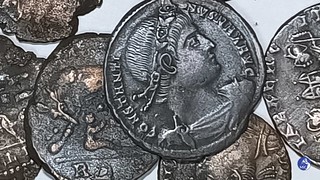 A diver who spotted something metallic not far from Sardinia's coast has led to the discovery of tens of thousands of ancient bronze coins.
A diver who spotted something metallic not far from Sardinia's coast has led to the discovery of tens of thousands of ancient bronze coins.
Italy's culture ministry said Saturday that the diver alerted authorities, who sent divers assigned to an art protection squad along with others from the ministry's undersea archaeology department.
ANCIENT GREEK COINS RECOVERED IN ITALY
This Barnaby's Magazine article discusses the recent repatriation of coins to Greece. There's not much substance and no links, reference or actual photos. There's a byline, but with the advent of AI-written articles it's hard to tell anymore. -Editor
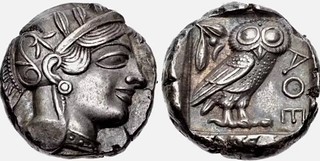 An unusual online advertisement caught the eye of the authorities when it offered five Ancient Greek coins for sale for just 1,500 euros. These coins were identified, as part of careful checks aimed at combating illegal trafficking of archaeological finds, by the Carabinieri of the Cultural Heritage Protection Unit of Monza. The coins were later returned to the Greek Ambassador to Italy, Eleni Sourani, in a handover ceremony in Rome.
An unusual online advertisement caught the eye of the authorities when it offered five Ancient Greek coins for sale for just 1,500 euros. These coins were identified, as part of careful checks aimed at combating illegal trafficking of archaeological finds, by the Carabinieri of the Cultural Heritage Protection Unit of Monza. The coins were later returned to the Greek Ambassador to Italy, Eleni Sourani, in a handover ceremony in Rome.
Their discovery has once again brought to light the widespread presence of illicit sales of historical artifacts online. It is a sad reality that looms over cultural heritage in the virtual market.
THE PARADOX OF PHYSICAL CRYPTOCURRENCY
We've been covering physical cryptocurrency for years. Stack's Bowers has held a number of sales, and Heritage is in the game, too. Andrew Crellin of Australia's Sterling & Currency published an article on the recent Heritage Otoh sale. Here's an excerpt - see the complete article online. -Editor
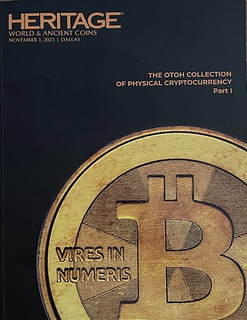 An interesting auction catalogue landed on my desk a few weeks back - it was for "The OTOH Collection of Physical Cryptocurrency", a pioneering sale in the world of numismatics.
An interesting auction catalogue landed on my desk a few weeks back - it was for "The OTOH Collection of Physical Cryptocurrency", a pioneering sale in the world of numismatics.
If you're anything like me, your brain may have gotten caught on a few of the words in that description - PHYSICAL CRYPTOCURRENCY!
Yes, if you didn't already know, physical cryptocurrency is not just a paradox, it is a real thing that exists in the world.
THE BOOK BAZARRE
PHYSICAL BITCOIN AS A NUMISMATIC COLLECTIBLE
Stack's Bowers Director of Consignments and Numismatics James McCartney published a timely article about physical bitcoins and cryptocurrency. -Editor
In this article and others in upcoming blogs, I will be focusing on the emerging numismatic category of Physical Bitcoin and Cryptocurrency. Included will be observations and updates aimed at spreading awareness and creating discussion around these innovative collectibles. We have seen a growing collector interest in this category over the past two years and are very excited to see what is in store over the next two years and beyond.
We are just about two weeks away from the first of two physical crypto sessions in our November 2023 Showcase Auction. This event celebrates a full decade since the end of production for the Casascius series in 2013. New bidders in our November sale can also request a complimentary copy of the standard reference for the category, the Encyclopedia of Physical Bitcoins and Crypto-Currencies by Elias Ahonen—while supplies last.
ENGRAVED CIA MEDALS OFFERED
Fascinating history behind these two rare, issued CIA medals. -Editor
CIA NAMED CASED NON PORTABLE AWARDS TO CIA AGENT
Ultra rare set of Agency otherwise known as the CIA Central Intelligence Agency Non Portable Awards to include 1) Cased Exceptional Service Medallion For the death resulting from service in an area of hazard. This medal is named to the reverse Richard C. Spicer and dated 1985. Edge of the medal is engraved MACO-NY. FINE SILVER-.999+ 2) Cased Intelligence Star For a voluntary act or acts of courage performed under hazardous conditions or for outstanding achievements or services rendered with distinction under conditions of grave risk.
LOOSE CHANGE: NOVEMBER 5, 2023
Here are some additional items in the media this week that may be of interest. -Editor
Roger Burdette published a CoinWeek article on the practice of stealing gold by hollowing out gold coins. Here's a short excerpt - see the complete article online for more. -Editor
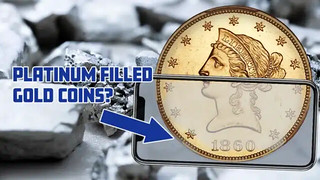 In 19th-century America and parts of Europe, a more sophisticated and deceptive method came into use along with the large influx of new gold from California and Australia. This used a real coin, such as a $10 eagle or a $20 double eagle, and preserved the faces and most of the edge in original condition. The counterfeiter did not attempt to copy the coin; rather, gold was removed from inside. Visually, the coin appeared genuine, but in reality it had been hollowed out, the gold removed, and the cavity filled with a cheap heavy metal such as platinum.
In 19th-century America and parts of Europe, a more sophisticated and deceptive method came into use along with the large influx of new gold from California and Australia. This used a real coin, such as a $10 eagle or a $20 double eagle, and preserved the faces and most of the edge in original condition. The counterfeiter did not attempt to copy the coin; rather, gold was removed from inside. Visually, the coin appeared genuine, but in reality it had been hollowed out, the gold removed, and the cavity filled with a cheap heavy metal such as platinum.
Pure platinum, at 21.45 grams per cubic centimeter, was noticeably denser than pure gold's 19.3 g/cc, but native platinum contained impurities (including palladium) that reduced its density enough to make it a good replacement for gold in counterfeiting.
Notice that until 1890 it was only one-fifth or less per ounce than the price of gold. It was not until about 1901 that platinum equaled, and then exceeded, gold's price.
To read the complete article, see:
Counterfeit Gold Coins Filled With Platinum: Hollow Gold
(https://coinweek.com/counterfeit-gold-coins-filled-with-platinum-hollow-gold/)
Other topics this week include meeting Richard Yeoman, a cyber attack on the British Library, and Silver Dollar Road. -Editor


